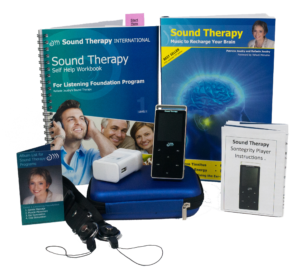I recently saw a segment on the ABC about Dystonia being treated with magnetic brain stimulation. This was presented as a new, experimental therapy which may help the condition. Dystonia is “a movement disorder that causes the muscles to contract and spasm involuntarily,” according to the dystonia foundation.
Sound Therapy is used to treat some particular issues that are hard to treat in other ways. These include tinnitus, ear related dizziness, sound discrimination problems, learning and auditory processing problems, speech problems or stuttering, memory loss including dementia or brain damage from stroke or accident.
However it is also beneficial for those who simply want to hear better, have more energy and focus and want to enhance creativity and communication or singing voice and musical ear.
Their site goes on to say:
“The neurological mechanism that makes muscles relax when they are not in use does not function properly. Opposing muscles often contract simultaneously as if they are 'competing' for control of a body part. The involuntary muscle contractions force the body into repetitive and often twisting movements as well as awkward, irregular postures. There are multiple forms of dystonia, and dozens of diseases and conditions include dystonia as a major symptom.”
Though it is a specific neurological condition, viewed simply, dystonia is an extreme form of the inability to relax. Where it is distinct from normal muscle tension is that the syndrome is so entrenched as to seem quite beyond voluntary control.
The interesting thing is, Physiotherapy and massage sometimes simply don’t work. This is perhaps because these methods address the end organ of the nervous system, the muscles themselves, rather than the neurological origin. They are, in a sense, treating the symptom rather than the cause.
However, the condition has been successfully treated by some well established complementary therapies which give us a way to address the problem closer to source. The first one that came to mind is one I have studied myself and which I think deserves more recognition than it has received. This is The Alexander Technique which is a highly developed form of neuromuscular re-education. Read about it here in relation to dystonia.
Having suffered myself from chronic neck tension for over 20 years, I then recovered from this over fifteen years ago when I studied the Alexander Technique. It is a technique which, once you learn it, you can apply to yourself, as it teaches us to be aware and self responsible of our own thoughts and muscle responses at a very subtle level. It is an amazing gift to have this kind of inner control instead of being at the mercy of our own muscle spasms and tension patterns every day.
The other method I have experienced that can have an unexpected but significant effect on chronic neck tension is Sound Therapy. This sounds rather odd to people who are not aware of the interconnectedness of the nervous system and the ear. Dr Weekes documents how the twelve cranial nerves relate to the ear in his excellent article here
http://weeksmd.com/2008/05/the-therapeutic-aspect-of-sacred-music/
Once you understand the intricate linkages between the ear and the rest of the nervous system, it makes sense that enhancing ear function can also enhance posture and relieve neck tension. The 11th cranial nerve, the spinal accessory nerve, has branches to the pharynx, (the throat) the larynx, and the 2nd, 3rd and 4th cervical nerves. It interacts with the ear via the Vagus nerve, that unique cranial nerve which is named after the vagabond because it wanders throughout the chest and abdomen after interacting with the ear drum and nerves behind the ear.
Now that we are aware of neural plasticity, we can draw on this understanding to apply the neurological tools of change and re-education to resolve many different chronic disorders, including dystonia.
Read more at
http://www.dystonia-foundation.org/pages/what_is_dystonia_/26.php


